
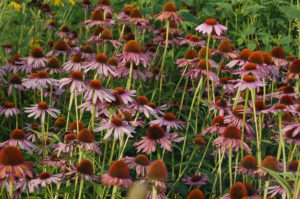
“The walking of which I speak has nothing in it akin to taking exercise, as it is called, as the sick take medicine at stated hours …but it is itself the enterprise and adventure of the day.”
Henry David Thoreau – Walking
Today’s walk was a solo; a couple of miles on a beautiful late-summer morning. Though fitness had crossed my mind as a motivation for the jaunt, I could not argue with Mr. Thoreau. The walk, undertaken as an important component of my day, was indeed justification enough.
Living in rural Sullivan County, Indiana I am blessed with the ability to amble down my lane and out onto the local roadway without much fear of interference from that nuisance one finds on most roads – traffic. This time I am a bit chagrined, as I start my jaunt, when a neighbor’s car passes me. On an errand to town I imagine. Most times I will have these two miles to myself and can walk on the left, right, or leisurely amble right down the middle of 225 South if I so choose. Odds are thus quite high that the only sounds impinging upon my tympanic membranes will be natural – northern cardinal, pileated woodpecker, wind caressing the leaves of the maples and oaks, a lingering cicada or a few late-to-bed katydids. I suppose a person fully committed to the urban life might find such a stroll alarmingly dull; no people to watch, no vehicles to appraise, no beckoning sidewalk café for coffee and the morning news. As for me, I do not relish the idea of spending this morning’s ramble and mediation with a crowd. The single car that passed this morning was intrusion enough thank you.
Yet, in spite of what I have said, do not imagine that I am really alone on this morning stroll. I have dozens of acquaintances with whom I share the break of day. They may be voiceless and immobile but they speak to me just the same. They energize my mind and bring a flood of memories, contemplations, and conjectures. My walk proceeds not as a dull plod but as a compulsory meditation upon the many living wonders residing near at hand. The friends, of whom I speak, so easily unheeded by many who would pass along this path are the common flowering plants of a lonely Indiana back-road.
Several of the acquaintances I meet remind me of why so many  communities in this area have descriptive names such as Prairie Creek, Prairieton, Indian Prairie, or Shaker Prairie. This morning, at various spots along my road, I am greeted by big bluestem, little bluestem, cup plant, tall goldenrod, common milkweed, Indian grass, and butterfly weed. All these represent remnants of the fingers of tallgrass prairie which probed the vacant spots along the western flanks of North America’s immense, eastern deciduous forest. It is impossible for me to consider these plants and not have my mind rush backwards as though I have exerted a forceful pull on the operative lever of H.G. Well’s time machine. I try with all my might to picture a sea of these plants, and many
communities in this area have descriptive names such as Prairie Creek, Prairieton, Indian Prairie, or Shaker Prairie. This morning, at various spots along my road, I am greeted by big bluestem, little bluestem, cup plant, tall goldenrod, common milkweed, Indian grass, and butterfly weed. All these represent remnants of the fingers of tallgrass prairie which probed the vacant spots along the western flanks of North America’s immense, eastern deciduous forest. It is impossible for me to consider these plants and not have my mind rush backwards as though I have exerted a forceful pull on the operative lever of H.G. Well’s time machine. I try with all my might to picture a sea of these plants, and many 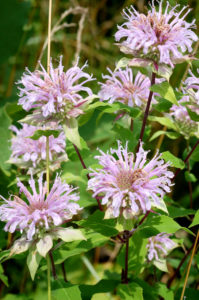 other species of course, stretching away to the horizon. What a vista it must have been; the bluestem, tall as a man on horseback, rippling in the wind and interspersed with inestimable acres of purple coneflower, leadplant, blazing star, rattlesnake
other species of course, stretching away to the horizon. What a vista it must have been; the bluestem, tall as a man on horseback, rippling in the wind and interspersed with inestimable acres of purple coneflower, leadplant, blazing star, rattlesnake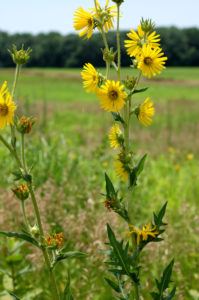 master, grama grass, cutleaf silphium, partridge pea, queen of the prairie, and rosinweed! A herd of American bison, numbering in multiples of a thousand, can be seen slowly cruising among the prairie plants and industriously converting sunlight energy into muscle, sinew, and bone. It is a grand scene that plays in my mind. Admittedly, my vision is tinged with melancholy as I recall that over ninety percent of North America’s tallgrass prairie is now gone. I am reminded of the words of the great conservationist Aldo Leopold. “What a thousand acres of Silphiums looked like when they tickled the bellies of the buffalo is a question never again to be answered, and perhaps not even asked.”
master, grama grass, cutleaf silphium, partridge pea, queen of the prairie, and rosinweed! A herd of American bison, numbering in multiples of a thousand, can be seen slowly cruising among the prairie plants and industriously converting sunlight energy into muscle, sinew, and bone. It is a grand scene that plays in my mind. Admittedly, my vision is tinged with melancholy as I recall that over ninety percent of North America’s tallgrass prairie is now gone. I am reminded of the words of the great conservationist Aldo Leopold. “What a thousand acres of Silphiums looked like when they tickled the bellies of the buffalo is a question never again to be answered, and perhaps not even asked.” 
But I refuse to be morose on such a beautiful fall morning. I admire the remnants of the once mighty prairie and walk onward in anticipation of seeing other friends. As I move along, I am reminded that our native plants are often freely mixed among others who exist here as a result of human handiwork. The number of introduced plant species encountered is quite staggering as I continue to contemplate the floral world along my route. Many of these plants came from Europe with the early immigrants to North America. Others have come by way of Asia. The Indiana Department of Natural Resources says that a quarter of the two-thousand species of vascular plants in Indiana are introduced. No wonder I am meeting so many foreigners this morning. I often find myself surprised to learn that a plant I had always assumed was native has in fact been transported here from some far, alien shore. Most of these plants have been here for so long that they have become naturalized into the landscape and do little harm. Others are concrete examples of good human intention gone horribly wrong. To be honest, they are the antitheses of plant friends. For example, standing here and there above the roadside ditches are three of the nastiest invasive plants in Sullivan County. Autumn olive, bush honeysuckle, and multiflora rose are all natives of Asia. Imported as ornamentals and to enhance wildlife habitat, they have become major problems. Multiflora rose was even promoted as a living fence at one time; I remember a neighbor whose cattle pasture was so enclosed. This plant, like the other two, produces a fruit attractive to birds and has thus been spread far and wide by means of the bird’s droppings. The formation of dense thickets, the crowding out of native plants, and the possession of thorns big enough to rip the flesh are the charms now offered throughout the countryside by this ghastly addition to Indiana’s flora. I’ve spent many a rabbit hunt cursing the nameless individual who first imported this plant. While autumn olive and bush honeysuckle lack the viciousness of multiflora rose, they do accomplish much the same damage in regards to their prolificacy and displacement of native plants. If nothing else, these plants should serve as monuments to the hubris and lack of foresight of humans. The list of invasive plants and animals abetted by the actions of mankind would fill a good sized book. The disastrous effect of invasives upon the native flora and fauna of various countries of the world would fill several volumes I imagine.
But, as I have said, most of our introduced plants behave themselves as well-mannered guests should. I find myself more accepting of these polite exotics. Certainly the introduced plants I now see are less intrusive 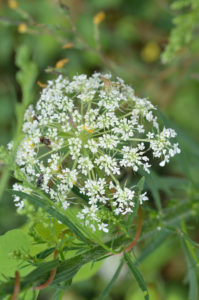 than the scoundrels mentioned above. In fact, I find them downright attractive. Queen Anne’s lace is a lovely, white-flowered native of Europe and a relative of the domestic carrot. There are also dandelions to be seen here and there. Another European native, this plant is also a common member of that diverse assemblage of flora that passes for my lawn. Many berate the dandelion for its audacity in marring their well-manicured yard. But I welcome it and sometimes take advantage of it in the spring when, upon experiencing a dearth of morels, I pick the blossoms and fry them in egg, flour, and butter. Thus prepared they are quite delicious. This morning I see chicory too; its vibrant blue flowers stand out like little neon signs along the road. Another Eurasian import, chicory has a long history of use by humans both as a food and as a coffee substitute.
than the scoundrels mentioned above. In fact, I find them downright attractive. Queen Anne’s lace is a lovely, white-flowered native of Europe and a relative of the domestic carrot. There are also dandelions to be seen here and there. Another European native, this plant is also a common member of that diverse assemblage of flora that passes for my lawn. Many berate the dandelion for its audacity in marring their well-manicured yard. But I welcome it and sometimes take advantage of it in the spring when, upon experiencing a dearth of morels, I pick the blossoms and fry them in egg, flour, and butter. Thus prepared they are quite delicious. This morning I see chicory too; its vibrant blue flowers stand out like little neon signs along the road. Another Eurasian import, chicory has a long history of use by humans both as a food and as a coffee substitute.
Strolling onward, scanning the roadside ditch, I notice a patch of cattails  taking advantage of the wet soil there. This plant has long intrigued me for the eclectic uses it offered generations of native peoples. The long, durable leaves could be woven into mats for floor or wall. The roots are quite edible. They remind me somewhat of cabbage. I’ve been told that cattail pollen has served as a substitute for flour in making pancakes. It is also a plant much favored for nesting by one of my favorite birds, the red-winged blackbird. Sadly, this plant has been replaced over much of its range here in Sullivan County by a non-native subspecies of Phragmites. This very tall invasive grass grows in dense stands, blocks shorelines, forms virtually impenetrable stands, and in my eyes has none of the virtues of the cattail.
taking advantage of the wet soil there. This plant has long intrigued me for the eclectic uses it offered generations of native peoples. The long, durable leaves could be woven into mats for floor or wall. The roots are quite edible. They remind me somewhat of cabbage. I’ve been told that cattail pollen has served as a substitute for flour in making pancakes. It is also a plant much favored for nesting by one of my favorite birds, the red-winged blackbird. Sadly, this plant has been replaced over much of its range here in Sullivan County by a non-native subspecies of Phragmites. This very tall invasive grass grows in dense stands, blocks shorelines, forms virtually impenetrable stands, and in my eyes has none of the virtues of the cattail.
Ahead there is a nice thicket of blackberry. The berries themselves are gone now but they bring back recent memories of a luscious blackberry cobbler, homemade and liberally covered with ice cream. They also remind 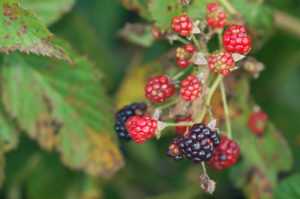 me of the labor intensive work required to collect them. One can expect badly scratched hands as a souvenir of gathering them as well. Here is a life lesson perhaps. Something as coveted as a blackberry cobbler does not come without effort.
me of the labor intensive work required to collect them. One can expect badly scratched hands as a souvenir of gathering them as well. Here is a life lesson perhaps. Something as coveted as a blackberry cobbler does not come without effort.
Next there comes an impressively tall mullein plant, another visitor from Europe. Its broad rosettes of soft, furry leaves lie close to the ground. Pioneer girls made doll blankets from these. As boys my brother and I f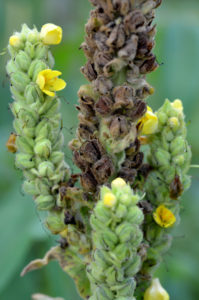 ound the long, erect flower stems to be good substitutes for lances and yes, of course we threw them at each other. The plant having been here for over two centuries, some Native American tribes used mullein for medicinal purposes. Smoking the dried leaves was said to treat respiratory conditions such as bronchitis.
ound the long, erect flower stems to be good substitutes for lances and yes, of course we threw them at each other. The plant having been here for over two centuries, some Native American tribes used mullein for medicinal purposes. Smoking the dried leaves was said to treat respiratory conditions such as bronchitis.
As I meander onward, I notice some pokeweed. It has grown since spring. As a result it is much taller than me now and has a significant accumulation of toxins in its roots, stems, leaves, and fruits. Earlier in the year the leaves could be washed and used in a salad or boiled and eaten as poke greens. A change of water 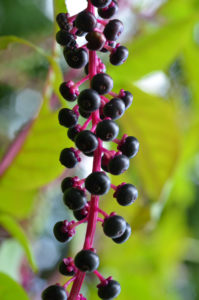 between boilings is recommended. Several species of birds feed on pokeweed berries and are unaffected by its poisonous components phytolaccine, phytolaccatoxin, and phytolaccigenin.
between boilings is recommended. Several species of birds feed on pokeweed berries and are unaffected by its poisonous components phytolaccine, phytolaccatoxin, and phytolaccigenin.
Here and there I see common milkweed plants. It is after all, as the name suggests, ubiquitous; at least along this road. These plants get their name from the milky looking sap that is exuded from an injured stem. This sap contains toxic cardiac glycosides, the potency of which varies among species. The plants have formed pods and will soon be drying, cracking, and releasing their airborne seeds. As a youngster, I found it impossible to walk by a milkweed plant and not be 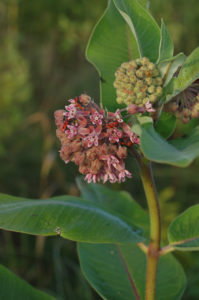 tempted to stop and help disperse the seeds. There was a captivating beauty in seeing the small, flattened, black seeds whisked into the air by a stiff breeze. Riding the air currents, their cotton-like fluff caught the wind and parachuted the seeds to great heights and far distances. I stood mesmerized by the spectacle of these little packets of starch and DNA being launched into the waiting landscape. What was their fate I wondered? How many would fall upon fertile ground? How many would find the inhospitable world of tarmac, concrete, or water? Away from my road, these plants have been significantly displaced by farming and herbicide application. This is detrimental to the monarch butterfly whose population has undergone drastic decline in the past twenty years or so. Their larvae feed exclusively upon milkweed leaves and incorporate the plant’s toxins into their tissues. Thus they become foul tasting and poisonous to predators. I see no monarchs on today’s walk.
tempted to stop and help disperse the seeds. There was a captivating beauty in seeing the small, flattened, black seeds whisked into the air by a stiff breeze. Riding the air currents, their cotton-like fluff caught the wind and parachuted the seeds to great heights and far distances. I stood mesmerized by the spectacle of these little packets of starch and DNA being launched into the waiting landscape. What was their fate I wondered? How many would fall upon fertile ground? How many would find the inhospitable world of tarmac, concrete, or water? Away from my road, these plants have been significantly displaced by farming and herbicide application. This is detrimental to the monarch butterfly whose population has undergone drastic decline in the past twenty years or so. Their larvae feed exclusively upon milkweed leaves and incorporate the plant’s toxins into their tissues. Thus they become foul tasting and poisonous to predators. I see no monarchs on today’s walk.
All along the way, where there are adjoining woodlands, I see an abundant plant which can be lethal. White snakeroot is plentiful in the open woodlots here and it contains a poison called tremetol. This toxin contaminates the 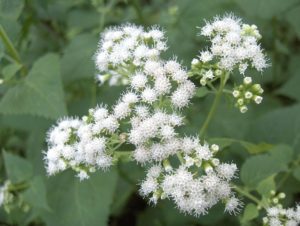 meat and milk of cattle which graze the plant. The result is a disease called milk sickness. This disorder was common in the 1800’s and caused the death of many people in the Midwest. When reading about this plant, the victim most famously mentioned is Abraham Lincoln’s mother Nancy Hanks Lincoln. She died from milk sickness in 1818. Eventually the connection between white snakeroot and the disease came to be understood, apparently as the result of herbal lore passed from a Shawnee woman. The flowers of the plant are attractive and my wife often uses them in fresh-cut bouquets. The fluffy, white blossoms arranged in flat-headed panicles upon the upper stems appear quite innocuous. A curious but uninformed observer would never guess the tragic history of this plant’s relationship with our pioneer ancestors.
meat and milk of cattle which graze the plant. The result is a disease called milk sickness. This disorder was common in the 1800’s and caused the death of many people in the Midwest. When reading about this plant, the victim most famously mentioned is Abraham Lincoln’s mother Nancy Hanks Lincoln. She died from milk sickness in 1818. Eventually the connection between white snakeroot and the disease came to be understood, apparently as the result of herbal lore passed from a Shawnee woman. The flowers of the plant are attractive and my wife often uses them in fresh-cut bouquets. The fluffy, white blossoms arranged in flat-headed panicles upon the upper stems appear quite innocuous. A curious but uninformed observer would never guess the tragic history of this plant’s relationship with our pioneer ancestors.
A last, fetching acquaintance greets me along my way. Standing tall with their vibrant, purplish pink flowers demanding notice is a nice stand of native Joe-Pye weed. I pause a moment to consider exactly what it is we mean when we describe a plant as a weed. Most often it seems the term is 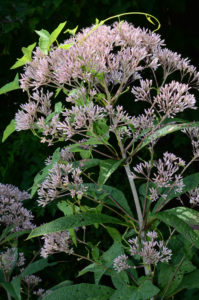 used for any plant that is growing where a human doesn’t want it. Marion Jackson in his The Natural Heritage of Indiana quotes R.W. Emerson’s definition of a weed. I like this one better. “What is a weed? A plant whose virtues have not yet been discovered.” Joe-Pye is a perfect example. Seen along the roadside from an automobile whizzing along at a mile a minute one might indeed be inclined to remark, “Look at that pretty weed.” But gardeners know better. Joe-Pye weed is virtuous as an ornamental plant. Its height and lush, umbrella-shaped, mauve flowers make it stand out as a bold addition to a garden or landscaping project. Furthermore, the very name of the plant alludes to its reputed virtues as a medicinal plant. Legend tells us that Joe Pye was the English name taken by a Native American healer who demonstrated the medicinal properties of the plant to settlers in New England. Teas made from Joe-Pye weed were said to be useful in treating everything from typhoid to rheumatism to impotence. Another name for the plant (gravel-root) was derived from its purported effect in eliminating kidney and gall bladder stones. Are there chemicals in this plant that act as genuine wonder drugs? Although many of our modern drugs are derived from plants, I know of no scientific evidence confirming the efficacy of Joe-Pye weed. Still, as I take leave of this beautiful plant, I can’t help but wonder. Could it be that the Native Americans, with their intimate connection with the natural world, knew something we have yet to fully elucidate and appreciate?
used for any plant that is growing where a human doesn’t want it. Marion Jackson in his The Natural Heritage of Indiana quotes R.W. Emerson’s definition of a weed. I like this one better. “What is a weed? A plant whose virtues have not yet been discovered.” Joe-Pye is a perfect example. Seen along the roadside from an automobile whizzing along at a mile a minute one might indeed be inclined to remark, “Look at that pretty weed.” But gardeners know better. Joe-Pye weed is virtuous as an ornamental plant. Its height and lush, umbrella-shaped, mauve flowers make it stand out as a bold addition to a garden or landscaping project. Furthermore, the very name of the plant alludes to its reputed virtues as a medicinal plant. Legend tells us that Joe Pye was the English name taken by a Native American healer who demonstrated the medicinal properties of the plant to settlers in New England. Teas made from Joe-Pye weed were said to be useful in treating everything from typhoid to rheumatism to impotence. Another name for the plant (gravel-root) was derived from its purported effect in eliminating kidney and gall bladder stones. Are there chemicals in this plant that act as genuine wonder drugs? Although many of our modern drugs are derived from plants, I know of no scientific evidence confirming the efficacy of Joe-Pye weed. Still, as I take leave of this beautiful plant, I can’t help but wonder. Could it be that the Native Americans, with their intimate connection with the natural world, knew something we have yet to fully elucidate and appreciate?
Turning toward home, I mull over the morning’s visit among my plant friends. I have been quite content upon my otherwise solitary walk. As the main enterprise of the day, the walk has given me much. The mental gymnastics spawned by my encounters with the plants have been substantial and entertaining. There has been pure esthetic appreciation, the consideration of humankind’s role in plant biogeography, contemplations of plant pharmacology, and reflections upon youthful memories. Just as importantly, there has been a constant, exceedingly powerful sense of being present in the moment. I have felt the persuasive awareness of being a member of the vast community of living things which make our earth so remarkably fecund and diverse. I dare say these considerations and emotions are available to you as well. Granted, you may not have the luxury of commandeering a rural road as your own personal byway. But, be not swayed. The local park, the nearby forest, even the city avenue await. They all have their plant communities standing in anticipation of your visit. Learn to identify some of your local plants. Walk among them. Really look at them. Think about them. Your new friends will reward you with many an enjoyable hour.
Image Credits: Hiker silhouette courtesy hikingproject.com Cattail courtesy USFWS at commons.wikimedia.org White Snakeroot by Homer Edward Price (flickr) All other images by the author
